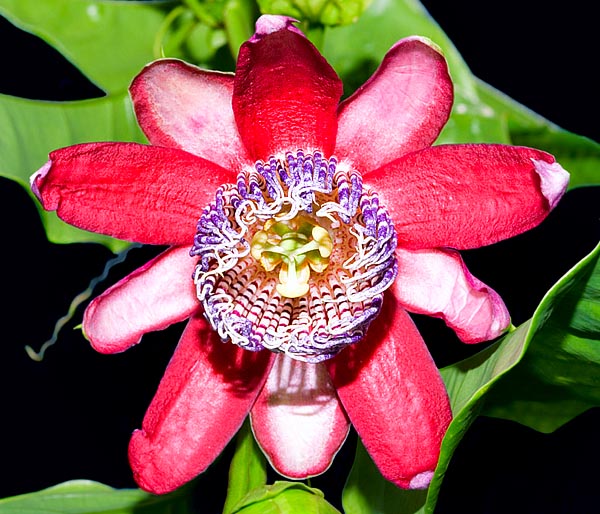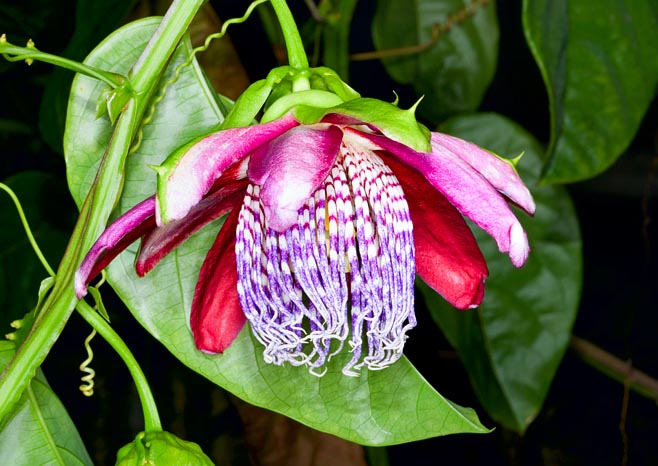Family : Passifloraceae

Text © Pietro Puccio

English translation by Mario Beltramini

Passiflora alata is a much floriferous with edible fruits tropical climber © Giuseppe Mazza
The name of the genus is the combination of the Latin terms “passio, -onis” = passion and “flos, -oris” = flower, with reference to the structure of the flower where the first Spanish missionaries did see the instruments of the Passion of Christ; the name of the species is the Latin term “alatus, a, um” = winged, with reference to the quadrangular stem with protruding edges.
Common names: fragrant granadilla, winged-stem passion flower, wingstem passion flower (English); passiflore du Brésil, (French); flor-da-paixão, maracujá-doce, maracujá-grande, maracujazeiro grande, maracutão (Portuguese-Brazil); pasionaria (Spanish).
The Passiflora alata Curtis (1788) is an evergreen semi-woody climbing species which anchors to the supports thanks to tendrils produced at the axil of the leaves, with stem having a quadrangular section with membranous wings at the edges.
The leaves, on an about 5 cm long petiole provided with 2-4 nectariferous glands, are alternate, entire, cordate with pointed apex, 10-15 cm long and 5-10 cm broad, with 7-8 lateral nervations; the stipules (appendages at the base of the petiole whose task is to protect the leaf during the first stages of development) are linear to lanceolate, 1-2 cm long, with entire or toothed margin.
The flowers are hermaphrodite solitary, axillar, very perfumed, of 10-12 cm of diameter, with 5 sepals and 5 oblong petals of carmine red colour inside, with the crown of filaments, about 3 cm long, streaked with white, red and violet, slightly curled at the apex.
The fruits are obovoid or pyriform, 8-12 cm long and 3-6 cm of diameter, yellow coloured when ripe containing numerous seeds immersed in a whitish pulp (aril). It reproduces by seed, kept in water for 1-2 days and placed in soil for sowing particularly draining, kept humid at the temperature of 22-25 °C, with variable germination times, usually long, even many months; the reproduction by cutting and layering is quite easy and allows having plants ready for the flowering.

An opening bud. The leaves do have medicinal properties © Giuseppe Mazza
Where the permanent cultivation in open air is not possible, it well adapts to the cultivation in pot in order to be sheltered in the winter period in a very luminous location, at a minimum temperature not lower than 14 °C; possible prunings are to be done by early spring.
The flowers are hermaphrodite, but self-sterile, for the crossed fecundation it would be necessary therefore the presence of another plant not gotten by vegetative way from the same, if there is an interest in the production of the fruits, then the pollen of the Passiflora caerulea can be used successfully for the fecundation.
The species is also cultivated for commercial purposes, especially in Brazil, where the fruit is highly appreciated thanks to its juicy, perfumed and pleasantly tasting pulp, suitable for the direct consumption or for beverages and sorbets; furthermore the leaves extracts are utilized in the Brazilian pharmaceutical industry for the anxiolytic properties.
Synonyms: Passiflora alata Dryand. (1789); Passiflora mauritiana A. Thouars (1805); Passiflora latifolia DC. (1828); Passiflora pyriformis DC. (1828); Passiflora tetradena DC. (1828); Passiflora brasiliana Desf. (1829); Passiflora maliformis Velloso (1829); Passiflora phoenicia Lindl. (1833); Passiflora mascarensis C. Presl (1844); Passiflora oviformis M. Roem. (1845); Passiflora sarcosepala Barb. Rodr. (1907).
→ To appreciate the biodiversity within PASSIFLORACEAE family please click here.
